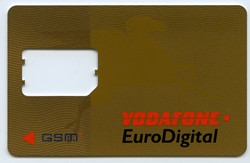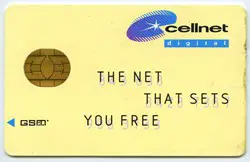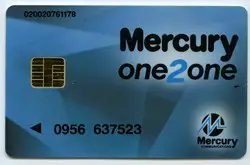The networks and tariffs

Vodafone
Vodafone was jointly with Cellnet Britain's first cellular network. It opened with the ETACS analogue system on 1 January 1985.
Vodafone first courted consumers, rather than business customers, in October 1992 with the LowCall tariff on the old analogue network, which offered cheaper line rentals in exchange for higher call chargers.
Vodafone was the first UK network to offer a GSM service in 1992. GSM offered the benefit of phones that worked in Europe as well as the UK. However, GSM phones, which were more expensive, were not popular even with business customers.
In 1993, Vodafone repackaged its digital service offering two tariffs, the business oriented EuroDigital and the consumer MetroDigital package. However, by September 1994 these two services had only 53,000 customers as opposed to 1,000,000 on ETACS.
Vodafone's tariffs in the early 90s were:
- Vodafone - standard ETACS service which began in 1985
- LowCall - low use tariff introduced in 1992
- EuroDigital - GSM business tariff
- MetroDigital - GSM consumer tariff
- Pay as You Talk - PAYG tariff
Typical costs (1994) (**)
| Tariff | Monthly rental | Peak calls (per min) | Off-peak calls (per min) |
|---|---|---|---|
| Business | £25 | 25p | 10p |
| LowCall | £12.77 | 43p | 17p |
| EuroDigital | £25 | 25p | 10p |
| MetroDigital (*) | £20 | 25p | 20p |
(*) If you were phoning from home MetroDigital cost 12.5p and 10p for peak and off-peak calls.
Vodafone was the first operator to offer a pre-paid service. However, it was hardly the pay and go services we know today. Vodafone Pre-paid was expensive and intended for customers with poor credit history, a bit like pre-paid gas and electric supplies.
Vodafone launched Pay as You Talk towards the end of 1997 on the analogue system, in competition to One2One's Digital PAYG service Up2You.

Cellnet
Cellnet was a joint venture between British Telecom and Securicor. It offered a similar ETACS service to Vodafone. Cellnet was always a little behind Vodafone in terms of innovation. Cellnet's directors failed to anticipate the huge growth in digital services for consumers. In 1994 Cellnet had only one GSM tariff, for high spending business customers. In 1995 Cellnet was expecting business users to switch to digital and consumers to take up the space left on the analogue system.
Cellnet was also the slowest to launch a PAYG service.
- Cellnet - standard ETACS service which began in 1985
- PrimeTime - high usage business tariff from the early 90s.
- LifeTime - light usage ETACS tariff
Typical costs (1994) (**)
| Tariff | Monthly rental | Peak calls (per min) | Off-peak calls (per min) |
|---|---|---|---|
| PrimeTime | £25 | 25p | 10p |
| LifeTime | £12.77 | 43p | 17p |
Cellnet is now O2 in the UK.

Mercury One2One
Mercury's One2One network started on 7 September 1993, promising to be a network for everyone. However, it initially served only the area inside the M25.
There were two tariffs, BusinessCall and PersonalCall. The innovative PersonalCall package offered free off peak local calls and was a serious competitor to landline phones. It was this package that probably saved One2One from oblivion. Quality problems dogged the original handsets and Orange soon offered superior coverage.
Typical costs (1994) (**)
| Tariff | Monthly rental | Peak calls (per min) | Off-peak calls (per min) |
|---|---|---|---|
| BusinessCall | £17.5 | 14p | 8p |
| PersonalCall | £12.50 | 25p | 10p |
One2One is now T-Mobile in the UK.
Orange
Orange launched in 1994. Managing director Hans Snook almost had a Gerald Ratner moment when he claimed that customers did not want free calls. Orange's tariffs did not include One2One's free local calls offer.
However, Orange's coverage went way beyond the M25 area offered by its rival and did not suffer the same quality issues with its handsets. Orange also was the first to bill by the second, rather than the minute and was the first network to offer text messages.
Typical costs (1994) (**)
| Tariff | Monthly rental | Peak calls (per min) | Off-peak calls (per min) |
|---|---|---|---|
| Talk 200 | £50 | 18p | 9p |
| Talk 15 | £15 | 25p | 13p |
References
(**) Source: 'Six characters in search of a mobile; Vodafone, Cellnet, Mercury or Orange?' by Monica Horten, published in the Independent, 17 September 1994.